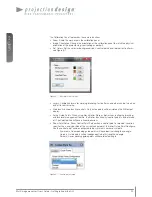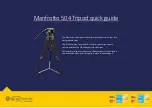
english
35
www.projectiondesign.com
7 Edge blending
7.1 Introduction
Edge Blending is a companion feature to Image Geometry Correction. Edge Blending ena-
bles the seamless projection of a large image using several overlapping projectors. Since
geometry correction for projection on non-flat surfaces is a built-in requirement in almost all
Edge Blending systems, the pairing of Edge Blending and Image Geometry Correction in the
same video signal processor is a natural one.
7.2 Edge blending algorithms
Multi image processing system support two different types of edge blending: Basic and
Advanced
7.2.1 Basic edge blending
Basic edge blending is used for simple and slightly curved surfaces. A percentage or a
defined number of overlapping pixels is specified. The overlapping region of each side (top,
bottom, left, right) of the image is then geometry corrected with the warping that is being ap-
plied to the image.
7.2.2 Advanced edge blending
Advanced edge blending is used for more complex surfaces like a dome (spherical). With
advanced edge blending, warping and blending is completely disconnected. After correct
geometry correction has been applied, multiple blend areas are defined to create the seam-
less image.
7.2.3 User interface for basic edge blending
To apply basic edge blending to an image, select “Blend” from the left hand toolbar, and
select Basic Blend Setup. The window in Figure 7-1 will appear.
Note!
Overlap (= shared pixels between two channels) must be applied on the IG.
Summary of Contents for WB1920
Page 2: ...english 2 Multi image processor User s Guide Introduction...
Page 10: ...english 10 Multi image processor User s Guide What s in the Box...
Page 26: ...english 26 Multi image processor User s Guide Getting to know the GUI...
Page 48: ...english 48 Multi image processor User s Guide Black Level Management...
Page 58: ...english 58 Multi image processor User s Guide Technical specifications 12 2 Mechanical...
Page 61: ......













































